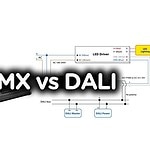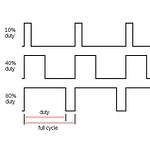The Digitally Addressable Lighting Interface (DALI), was made in Europe and has been widely used there for a long time. Even in the U.S., it’s getting more and more popular. DALI is a standard for digitally controlling individual light fixtures using a low-voltage communication protocol that can both send data to and receive data from the lights. This makes it a useful tool for building information monitoring systems and controls integration. Using DALI, you can give each light in your home its own address. You can have up to 64 addresses and 16 ways to divide your home into zones. DALI communication is not affected by polarity, and it can be set up in many different ways.
What is DALI?
DALI stands for “Digital Addressable Lighting Interface.” It is a digital communication protocol to manage lighting control networks in building automation projects. DALI is a trademarked standard that is used all over the world. It makes connecting LED equipment from many manufacturers easy. This equipment can include dimmable ballasts, receiver and relay modules, power supplies, dimmers/controllers, and more.
DALI was made to improve the 0-10V lighting control system by adding to what Tridonic’s DSI protocol could do. DALI systems let the control system talk to each LED driver and LED ballast/device group in both directions. Meanwhile, 0-10V controls only let you talk to them in one direction.
The DALI protocol gives LED control devices all the commands. DALI protocol also gives communication channels they need to control building lighting. It is also scalable and can be used for simple and complicated installations.
Why choose DALI?
DALI can help designers, building owners, electricians, facility managers, and building users control digital lighting more effectively and flexibly. As a bonus, you can be sure it will work perfectly with lighting equipment from many companies.
In the most straightforward setups, like single rooms or small buildings, a DALI system can be a single switch that controls many LED lights powered by a DALI-compatible power supply. So, there is no longer a need for separate control circuits for each fixture, and setting up takes the least amount of work possible.
LED ballasts, power supply, and device groups may all be addressed using DALI. That makes it ideal for large buildings, office complexes, retail spaces, campuses, and similar settings where space and use needs are subject to change.
Some other benefits of controlling LEDs with DALI are as follows:
- Facility managers would benefit from being able to check on the status of each fixture and ballast. It takes a lot less time to fix things and replace them.
- Because DALI is an open standard, it is easy to combine products from different manufacturers. It also helps to upgrade to better technology as it becomes available.
- Centralized control and timer systems make it possible to make lighting profiles. Best for ease of use, peak demand, venues with more than one scene, and saving energy.
- DALI is easy to set up because it only needs two wires to connect. Installers don’t have to be skilled because you don’t have to know how the lights will be set up in the end or label and keep track of the wiring for each fixture. The input and output are both done with two cables.
How to control DALI?
Standard light bulbs and fixtures are used in DALI installations. But the ballasts, receiver modules, and drivers differ. These parts connect DALI’s two-way digital communications, which can be set up in many different ways, to a central control system, which can be anything from a laptop to a high-tech lighting control desk.
Centralizing fixed light switches makes it possible to control a single light or the whole lighting circuit (aka a lighting zone). When the switch is flipped, all the lights in the same “group” are told to turn on or off simultaneously (or the brightness is adjusted).
A basic DALI system can take care of up to 64 LED ballasts and power supplies (also known as a loop). All the other devices connect to the DALI controller. Most of the time, several separate loops will be linked together and run as one extensive system to control the light over a larger area.
What is a DALI bus?
In a DALI system, control devices, slave devices, and the bus power supply connect to a two-wire bus and share information.
- The hardware that runs your LEDs is called “control gear,” It also gives your LEDs their light.
- Slave devices, which are also called “control devices, “These devices include both the input devices (like light switches, lighting control desks, etc.). They also include application controllers which analyze input and send the necessary instructions. They do it to adjust power to the appropriate LED.
- You need to power the DALI bus to send data. So bus power supplies are essential. ( using round 16V when there is no communication, more when instructions are being communicated).
Interoperability criteria are part of the current DALI standard. This lets certified products from different manufacturers work together on the same DALI bus.
On a single DALI bus, control devices and control equipment can each have up to 64 addresses. A “network of networks” comprises several buses that work together in more extensive systems.
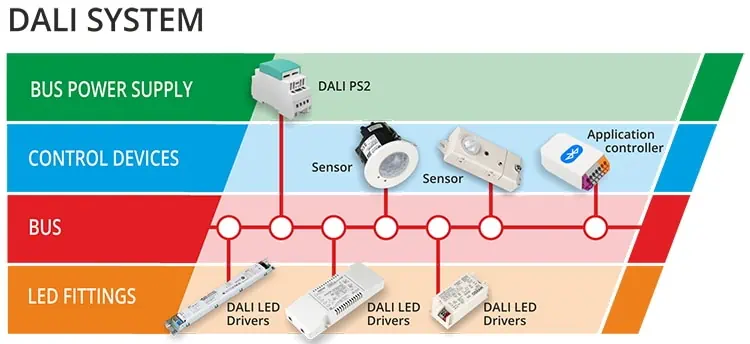
Key features of DALI
- It is a free protocol, so any manufacturer can use it.
- For DALI-2, certification requirements ensure that devices made by different companies will work together.
- Setting it up is easy. You can lay power and control lines next to each other because they don’t need to be shielded.
- The wiring can be set up in the shape of a star (hub and spokes), a tree, a line, or a mix of these.
- Because you can use digital signals for communication instead of analog ones, many devices can get the same dimming values, which makes dimming very stable and accurate.
- The system’s addressing scheme ensures that each device can be controlled separately.
Compatibility of DALI products with each other
The first version of DALI didn’t work well with other systems. It didn’t work because the specification was too narrow. Each DALI data frame only had 16 bits: 8 bits for the address and 8 bits for the command. This meant that you could send many commands that were very limited. Also, there was no way to stop commands from being sent at the same time. Because of this, many different companies tried to make it better by adding features that didn’t work well with each other.
With the help of DALI-2, this problem got fixed.
- DALI-2 is much more complete and has many more features than its predecessor. This means that specific manufacturers can no longer make changes to DALI.
- The Digital Illumination Interface Alliance (DiiA) owns the DALI-2 logo and has established strict rules about how it can be used. One of the most important is that for a device to have the DALI-2 logo. It must first be certified as meeting all the IEC62386 standards.
Even though DALI-2 lets you use DALI and DALI components together, you can’t do everything you want to do with DALI-2. This lets DALI LED drivers, the most common type, work in a DALI-2 system.
What is 0-10V dimming?
0-10V dimming is a way to change the brightness of an electric light source by using a range of direct current (DC) voltage from 0 to 10 volts. 0-10V dimming is the easiest way to control the brightness of lights. It allows for smooth operation and dimming to 10%, 1%, or even 0.1% of full brightness. At 10 volts, the light is as bright as it can get. The lights go to their lowest setting when the voltage drops to zero.
Sometimes, you may need a switch to turn them off completely. This simple lighting management system works with your LED lights. Thus, giving you different lighting options and setting the mood. A 0-10V dimmer is a reliable way to make lighting that you can change to fit any mood or task. Or you can create an elegant atmosphere in places like bar and restaurant seating.
How does DALI compare with 1-10V?
DALI was made for the lighting business, like 1-10V. Various vendors sell parts for controlling lighting. Such as LED drivers and sensors with DALI and 1-10V interfaces. But that’s pretty much where the similarities end.
The main ways that DALI and 1-10V are different from each other are:
- You can tell the DALI system what to do. Grouping, setting scenes, and dynamic control become possible like changing which sensors and switches control which lights fixtures when the office’s layout changes.
- Unlike its predecessor, an analog system, DALI is a digital system. This means that DALI can dim lights consistently and let you control them more precisely.
- Because DALI is a standard, things like the dimming curve are also standardized. So devices made by different companies can work together. Because the 1-10V dimming curve isn’t standardized. So using drivers from different manufacturers on the same dimming channel could lead to unexpected results.
- One problem with 1-10V is that it can only control basic on/off and dimming functions. DALI can control and change colors, test emergency lighting and give feedback. It can also make complicated scenes, and do much more.
What are the primary differences between DT6 and DT8?
- DT8 commands and features are only for managing colors, but you can use DT6 functions with any LED driver.
- You can use Part 207, Part 209, or both for a color-changing LED driver. In both cases, Parts 101 and 102 are also implemented.
- A single DALI short address is all that is required for a DT6 LED driver to adjust the brightness of a string of LEDs in accordance with a typical dimming curve.
- One DALI short address can control the outputs of any number of DT8 LED drivers. This lets a single channel control both the color temperature and brightness of the light.
- By using DT8, you can reduce the number of drivers needed for an application, the length of the installation’s wiring, and the number of DALI addresses. This makes design and commissioning easier.
The most commonly-used DT numbers are:
| DT1 | Self-contained emergency control gear | Part 202 |
| DT6 | LED drivers | Part 207 |
| DT8 | Colour control gear | Part 209 |
How does DALI compare with KNX, LON, and BACnet?
Protocols like KNX, LON, and BACnet control and track the different systems and appliances in a building. Since you can’t connect these protocols to any LED drivers, they can’t be used to control lights.
But DALI and DALI-2 were made with lighting control in mind from the start. Their command sets include many commands that are only used for lighting. Dimming, changing colors, setting up scenes, doing an emergency test and getting feedback, and lighting based on the time of day are all part of these functions and controls. A wide range of lighting control parts, especially LED drivers, can connect directly to DALI.
Building management systems (BMSs) often use KNX, LON, BACnet, and other similar protocols. They use it to control the whole building. That also includes the HVAC, security, entry systems, and lifts. DALI, on the other hand, is used to control only the lights. A gateway connects the building management system (BMS) and the lighting system (LSS) when needed. This lets the SPS turn on the DALI lights in the hallways in response to a security alert.
How are DALI lighting systems wired?
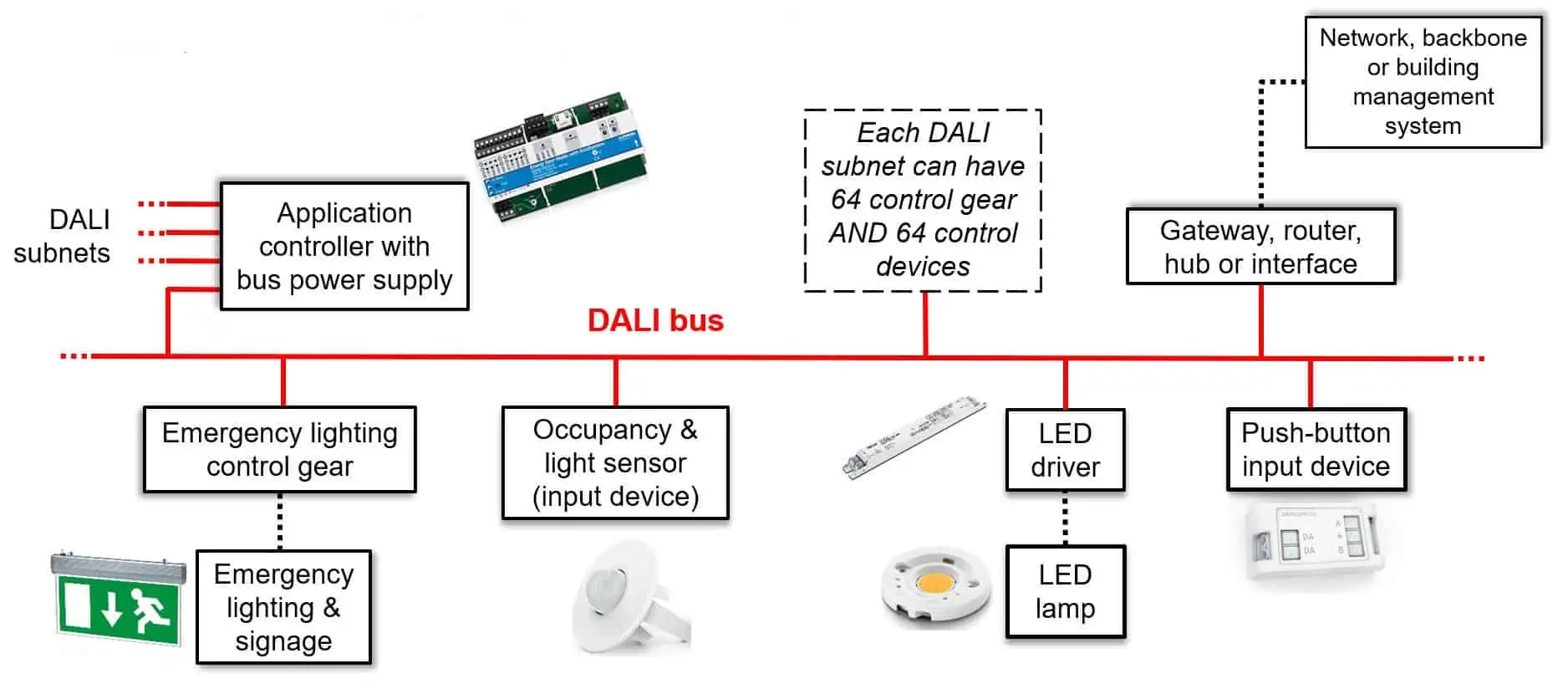
DALI lighting solutions use a master-slave architecture. So that the controller can be the information hub and the luminaires can be the slave devices. The slave components respond to requests from the control for information. Or the slave component carries out tasks that have been planned, such as ensuring the unit works.
You can send the digital signals over a control wire or bus with two wires. Even though cables can be either positively or negatively polarized. It is common for control devices to be able to work with either. You can wire DALI systems with standard five-wire cabling, so special shielding is unnecessary.
Since a DALI system doesn’t need wiring groups, you can connect all wires parallel to the bus. This is a significant change from traditional lighting systems. Because the commands sent from the control include all the information needed to turn on the lights, there is no need for mechanical relays. Because of this, the wiring for DALI lighting systems is simple, which gives them more flexibility.
Once you complete the wiring, the software on the controller can be set to work with the system. Because the system is flexible, you can build and use different lighting situations and programs without changing the physical wiring. All the light’s settings are very flexible, so you can change the curves and ranges of how bright it gets.
Where are DALI lighting systems used?
DALI is a lighting technology that you can change and is cheap. Most of the time, you can find these types of centralized lighting systems in big commercial spaces. DALI is mainly used in businesses and institutions. But people are starting to use it more often in their homes as they look for better ways to control their lights.
Even though you can add a DALI system to a building that is already up. DALI works best when designed and built from the ground up. This is because when you put in place a brand-new DALI system, there is no need for separate lighting control circuits. Retrofitting an old system but makes it impossible to install the simpler and more efficient DALI wiring system because the control circuits are already in place.
DALI dimming vs. dimming of other kinds
● Phase Dimming
Phase dimming is the easiest and most basic way to lower the brightness of a light, but it is also the least effective. Here, the control is done by changing the shape of the sine wave of the alternating current. This makes the light less bright. This method doesn’t need dimmer switches or other fancy dimming cables. But this setup doesn’t work well with modern LEDs, so we need to find better alternatives. Even if you use LED phase dimming bulbs, you can’t notice a drop in light intensity below 30%.
● DALI Dimming
You must use a control cable with two cores when putting in a DALI dimmer. Even after the initial installation, these control systems can digitally rearrange the lighting circuits within limits already set. The precise lighting control that DALI lighting offers will help LED downlights, LED accent lights, and LED linear systems. Also, these systems have the most comprehensive range of dimming of any currently on the market. With new improvements, the latest versions of DALI can now control both RGBW and Tunable White lights. Using DALI dimming ballasts for tasks that only need a change in color is a very efficient way to do things.
● DMX
DMX is more expensive than other ways to control lights, and installing it requires a special control cable. The APIs of the system allows for precise addressing and can be used in advanced ways to change colors. Most of the time, DMX is used for things like home theater lighting and lighting for pools. DMX is used in a lot of professional systems these days. But, the high cost of setting up makes other options look better.
Dim to dark in the DALI system
With good quality LED drivers and DALI, you can reduce the light intensity by no more than 0.1%. Some of the older, less complicated ways to dim LED lights, like the phase dimming method, may not be as efficient. This part of DALI dimming is essential because it shows how well these systems can work with how people see.
Because of how our eyes work, the controls for dimming the light should be adjustable down to at least 1%. Our eyes still see a 10% dimming as a 32% brightness level, so the ability of DALI systems to go from dim to dark is a big deal.
DALI dimming curve
Because the human eye is not sensitive to a straight line, logarithmic dimming curves are perfect for DALI lighting systems. Even though the change in light intensity looks smooth because there isn’t a linear dimming patternt.
What is a DALI receiver?
When used with a DALI controller and a transformer with the proper rating, the DALI dimming receivers give you complete control over your LED tape.
You can get a single-channel, two-channel, or three-channel dimmer. Depending on how many separate zones you need to control. (The number of channels a receiver has will tell you how many zones it can work in.)
Each channel requires five amps. The power supply can accept 100-240 VAC and put out 12V or 24V DC.
Advantages of DALI dimming
- DALI is an open standard that ensures devices from different manufacturers always work the same way when connected. You can also switch out your current parts for newer, better ones whenever they become available.
- Easy to put together With DALI five-wire technology, you don’t have to divide your lights into zones or keep track of each control line. There are two wires connected to this system. These wires are where the electricity enters and leaves the system.
- The main control board A single lighting control system can be used simultaneously in two or more places. Large commercial buildings can have their lighting scenes set up to meet peak demand, so they can hold many events at once and use less energy.
- Tracking and reporting that you can count on Because DALI works both ways. You can always get the most up-to-date information about the circuit’s parts. Each light’s status and energy use can be kept track of.
- Controls for the lights that can be set up front Like most other modern technology. You can change the lighting in your room to meet your exact needs. For example, you can change how much natural light comes into your room by changing how bright your daylight bulbs are.
- You can make changes to the setup quickly. After a while, you might want to change up your lights and get something fancier. There’s no need to take anything apart or rip the ceiling from under the bed. There is software that can do the programming.
Disadvantages of DALI dimming
- One of the main problems with DALI dimming is that the cost of controls is high at first. Especially for new installations. But in the long run, you won’t have to worry about the high costs of maintenance that come with other types of lighting.
- Keeping up with maintenance For the DALI system to work, you must make a database that links LED addresses to the right controllers. For these systems to perform at their best, you must build and keep them in good shape.
- Set up on your own It might seem like DALI is an easy concept to understand in theory. But you can never set it up on your own. Since the design, installation, and programming are more complex, So, you will need an expert installer.
How long has DALI been around?
The history of DALI is fascinating. The original idea for this came from European ballast makers. The first ballast company worked with three others to propose getting the International Electrotechnical Commission (IEC) to make a standard for how ballasts talk to each other. In the middle of it all, in the late 1990s, the United States also got involved.
Pekka Hakkarainen, director of technology and business development at Lutron Electronics in Coopersburg, PA, and chair of the Lighting Controls Council at the National Electrical Manufacturers Association in Rosslyn, VA, says that the standard is part of the IEC standard for fluorescent ballasts and is one of the standard’s annexes (NEMA). A set of rules for communicating with ballast that is generally accepted are given.
In the late 1990s, the first DALI LED drivers and ballasts came out in the United States. By 2002, DALI had become a standard around the world.
FAQs
DALI is an open and supplier-independent standard used for lighting control in buildings. You can configure it in various ways without requiring changes to how devices are wired or connected.
DALI dimmable LED drivers combine a dimmer and a driver into one unit. This makes them perfect for adjusting the brightness of LED lights. The DALI dimmable LED driver lets you dim the light from 1% to 100%. They give you a wide range of lighting effects and making it easy to manage your lamps.
You can give every single fixture in the group same command when you use 0-10v. Devices can communicate with one another in both directions using DALI. A DALI fixture will not only receive an order to dim. But it will also be able to send a confirmation that it has received the command and carried out the demand. In other words, it can do all these things.
Modern light dimmers not only reduce your energy consumption. They also increase the lifespan of your light bulbs.
Single-pole dimmers. Three-way dimmers. Four-way dimmers
Phase dimming is the technique by which “Phase-cut” dimmers operate. They operate by using line input power (also known as 120V “house power”) and modulating the signal to reduce the power to the load. If the signal is “chopped,” the voltage delivered to the load drops, reducing the amount of light produced.
The “Digital Addressable Lighting Interface” (DALI) is a communication protocol. You can use it for building lighting applications that exchange data between lighting control devices. Such as electronic ballasts, brightness sensors, and motion detectors.
While DMX is a centralized lighting control system, DALI is decentralized. DALI can support 64 connections, but DMX can provide up to 512 connections. The DALI lighting control system operates slowly, but the DMX lighting control system works quickly.
There should never be more than 64 DALI devices on one DALI line. The best practice advises allowing 50–55 devices per line.
A driver with a wattage capacity of at least 10% greater than what the LED tape needs to ensure a longer lifespan.
The primary component of DALI is a bus. The bus is made up of two wires used to send digital control signals from sensors and other input devices to an application controller. To generate outgoing signals for devices like LED drivers. The application controller applies the rules it has been programmed with.
There are two main voltage cables needed for the DALI control circuit. DALI is protected against polarity reversal. The same wire can carry both mains voltage and a bus line.
The messaging between devices in a DSI system is identical to that of a DALI system. The only difference is individual light fixtures are not addressed in a DSI system.
Summary
DALI is inexpensive and easy to change to fit different situations. This lighting system is excellent for businesses because you can control it from one place. It works as a simple lighting system for both new and old buildings. DALI makes it possible to get the benefits of wireless lighting controls. Benefits such as increased efficiency, compliance with building codes. Also the ability to work with other systems, and the ability to meet different lighting needs.
The DALI dimming system makes sure that your lighting is both practical and pleasant to look at.
We are a factory specializing in producing high-quality customized LED strips and LED neon lights.
Please contact us if you need to purchase LED lights.
